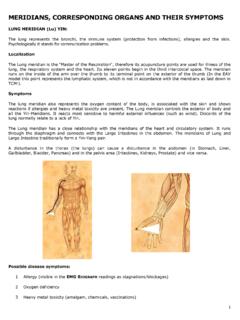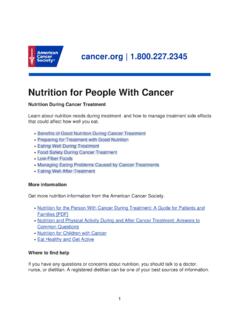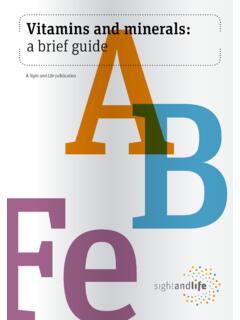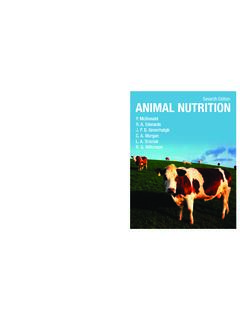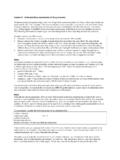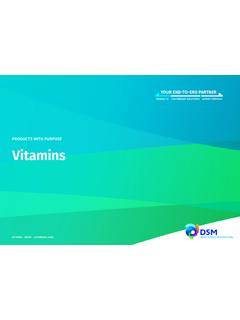Transcription of Liver phases 1 and 2 detoxification pathways
1 1 Liver phases 1 and 2 detoxification pathways What are the symptoms of a dysfunctional Liver ? Abnormal metabolism of fats (lipids) leading to Abnormalities in the level of fats in the blood stream elevated LDL cholesterol and reduced HDL cholesterol and elevated triglycerides. Arteries blocked with fat, leading to high blood pressure, heart attacks and strokes. Fatty Liver and build up of fat in other body organs. Obesity and /or inability to lose weight Sluggish metabolism External signs Coated tongue Bad breath Red palms and soles Flushed facial appearance or excessive facial blood vessels (capillaries/veins) Acne, Rosacea Yellow conjunctiva on the eyes Red swollen itchy eyes (allergic eyes) Dark circles under the eyes Brownish spots and blemishes on the skin ( Liver spots) Rashes and itchy skin (pruritis)
2 Digestive Problems Gall stones and gall bladder disease Intolerance to fatty foods Intolerance to alcohol Indigestion Reflux Nausea Abdominal bloating Constipation Irritable bowel syndrome Haemorrhoids Nervous System Depression Mood changes such as anger and irritability Poor concentration and "foggy brain" Overheating Recurrent headaches associated with nausea Immune dysfunction Allergies- sinus, hay fever, asthma, dermatitis, hives, etc. Skin rashes and inflammations Chemical and food sensitivities Auto-immune diseases Chronic Fatigue Syndrome and Fibromyalgia Recurrent viral, bacterial and parasitic infections Blood Sugar Problems Craving for sugar Hypoglycaemia Mature onset diabetes is common in those with a fatty Liver Hormonal imbalance Intolerance to hormone replacement therapy ( side effects) Menopausal symptoms such as hot flushes may be more severe Pre-menstrual syndrome may be more severe Details of Liver Functions Liver Functions: The Liver has a number of important functions, some of the main ones being: detoxification of potentially toxic chemicals from both inside and outside of the body including drugs, alcohol and toxins from intestinal microbes.
3 Accomplished with antioxidant nutrients and enzymes such as glutathione. The Liver detoxifies these harmful substances by a 2 complex series of chemical reactions. The role of these various enzyme activities in the Liver is to convert fat soluble toxins into water soluble substances that can be excreted in the urine or the bile depending on the particular characteristics of the end product. Storage of sugar as 'glycogen' and regulation of blood sugar levels. Production and storage of proteins as well as the regulation of many substances involved in protein metabolism. Production of bile which aids in the digestion of fats. Production of blood proteins, clotting factors and substances important to the production of red blood cells (erythrocytes) Regulation of a number of hormones. Neutralization of 'free-radicals' by antioxidants.
4 Free radicals are highly reactive oxygen molecules that can damage tissues. Storage of vitamins, mainly iron, copper, B12, vitamins A, D, E and K It plays an important role in digestion (breaking nutrients down) Involved with assimilation (building up body tissues). Red blood cells, which are responsible for carrying oxygen around the body, are recycled in the Liver Many factors determine whether the Liver performs its critical functions well. Too much pressure on the Liver from overeating rich or poor-quality food, environmental stresses, overwork or emotional stress can cause Liver overload, leading to a decreased ability to clear toxins and hormones and manufacture bile. Foods which contain high levels of antioxidants help to protect the Liver and keep it healthy while other foods cleanse the Liver .
5 Click here to view the different steps of detoxification of a healthy or unhealthy Liver . The symptoms of a sluggish or overtaxed Liver are varied and can include excess weight, Liver and gall bladder diseases, headaches and migraines, digestive problems, allergies, immune system problems such as hay fever and asthma, food and chemical sensitivities, constipation, unexplained fatigue, skin itching and irritation, PMS and other menstrual problems. Foods to Eat for Liver Health: There are certain foods that help to protect and detoxify the Liver itself so that it can perform better to detox the entire body: Apples contain pectin which helps to bind and excrete heavy metals right off the intestines. This directly helps to reduce the load of filtration on the Liver . Beets, carrots, red onions and aubergine (eggplant) contain flavonoids and beta-carotene which are potent antioxidants.
6 Garlic contains allicin and the mineral selenium, both antioxidants. It assists the removal of heavy metals from the Liver . Eggs, brown rice and whole grains, broccoli and spinach contain B-complex vitamins which improve Liver function and promote Liver decongestion. Vitamin B12 helps to metabolize fats and improves Liver health. Cruciferous vegetables such as cauliflower, broccoli, cabbage, Brussels sprouts, Bok Choy, kale, radishes, and turnips contain glucosinolates which help the Liver produce enzymes for detoxification . Grapefruits are rich in antioxidants and help in natural detoxification of Liver . 3 Bitter vegetables such as bitter gourd, dandelion greens, mustard greens and chicory promote the production and flow of bile. Tips for a healthy Liver : Eat organically produced foods as much as possible to avoid toxic chemical residues.
7 Avoid artificial flavorings and preservatives. Avoid damaged fats such as hydrogenated fats found in many processed foods. Use cold pressed oils and do not use them for cooking. Only a little butter, a saturated fat (coconut oil), should be used for cooking. Cooking with olive oil is still controversial. If used then do not heat it to a high temperature and add AFTER food has been removed from heat. Make sure your nuts and seeds are really fresh. Avoid excess saturated animal fat like sausage, bacon, salami, hot dogs, high fat dairy products like whole milk, ice cream and cheese. Alcohol is known to be a powerful toxin that will damage the Liver . Treating your Liver well by following the above advice will have a huge impact on your health and longevity. Liver detoxification The major percentage of blood being filtered by the Liver is from the portal vein, which carries blood from the intestines.
8 The Liver can remove a broad spectrum of microorganisms such as bacteria, fungi, viruses and parasites from the blood, which is desirable, as we certainly do not want these building up in the blood and invading deeper parts of the body. Infections and parasites often come from the contaminated water supplies found in large cities, and indeed other dangerous organisms may find their way into your gut and blood stream from these sources. This can cause chronic infections and poor health, so it is important to protect your 4 Liver from these microorganisms. The safest thing to do is drink water that has been filtered and sterilized. High loads of unhealthy microorganisms can also come from foods prepared in conditions of poor hygiene by persons who are carrying bacteria, viruses or parasites on their skin. Foods, especially meats that are not fresh or are preserved, also contain a higher bacterial load, which will overwork the Liver if they are eaten regularly.
9 Many of the toxic chemicals that enter the body are fat- soluble , which means they dissolve only in fatty or oily solutions and not in water . This makes them difficult for the body to excrete. Fat soluble chemicals have a high affinity for fat tissues and cell membranes, which are composed of fatty acids and proteins. In these fatty tissues of the body, toxins may be stored for years, being released during times of exercise, stress or fasting. During the release of these toxins, several symptoms such as headaches, poor memory, stomach pain, nausea, fatigue, dizziness and palpitations can occur. General Liver detoxification Nutrients Foods to aid detoxification : Beetroot and artichoke: helps with Liver drainage Broccoli, cauliflower and other cruciferous vegetables: these aid cytochrome P450 activity Protein Radish, watercress: rich in sulphur Albion family vegetables: garlic, onions High fiber foods such as whole grains, psyllium, flax seeds, fruit and vegetables: fiber binds toxins and eliminates them through the GI tract 5 Supplements to aid Liver detoxification : B-complex vitamins: necessary co-factors used in Phase 1 detoxification Digestive enzymes: may be necessary to ensure that protein is adequately digested and glycine is readily available Essential fatty acids N-acetyl cysteine (NAC).
10 An immediate precursor to glutathione, a potent antioxidant and among the most import detoxification nutrients for the Liver Reduced glutathione Selenium, zinc, magnesium and manganese; possibly iron and copper if used with caution Taurine (a useful combination product is magnesium taurate) Vitamins C and E and beta carotene. Inositol & Methionine: lipotropic agents (help with the breakdown of fat in metabolism) that work to transport fat out of the Liver High ORAC vegetable extract blend with polyphenols (a phytonutrient) Vitamins and minerals particularly the B vitamins play a major role, acting as co-factors for many enzyme systems including those of Liver detoxification , therefore making sure you consume enough of the B complex group of vitamins is of prime importance for optimum detoxification .

